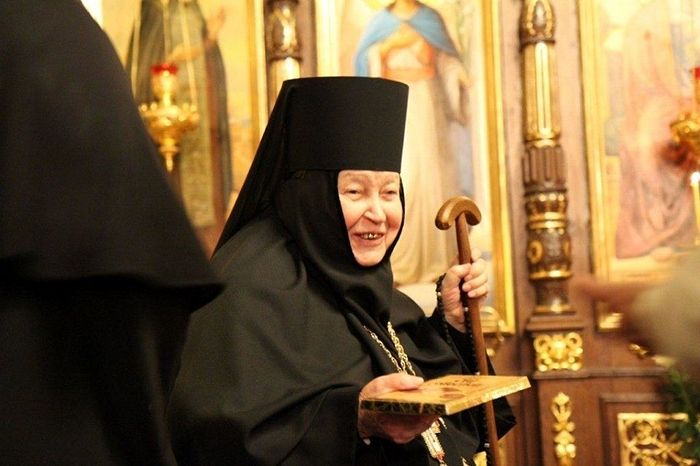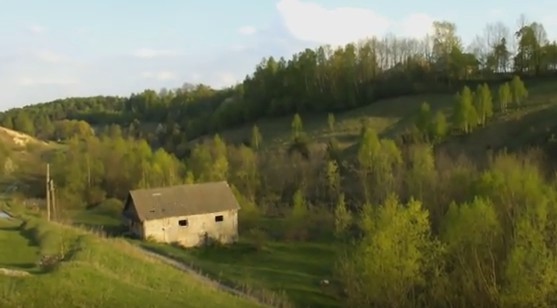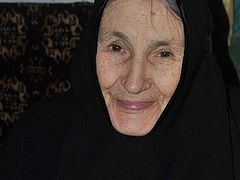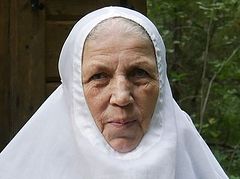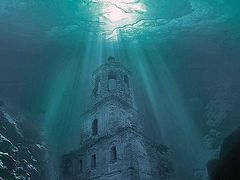Another trip to the Pochaev Lavra in late January was crowned with the news that the abbess of the Kremenets Monastery, located fifteen miles to the northeast of Pochaev, Mother Marionilla (Panasyuk), was celebrating her patron saint day, her eighty-seventh birthday, and the seventieth anniversary of her monastic life. I wanted to see Mother, to be at the service, and to take a photo on this festive day for the monastery.
At Kremenets Monastery
My previous meeting with the oldest abbess of the Ukrainian Orthodox Church took place nine years ago, and I was happy to see the abbess of the ancient Volyn Monastery in good health. The abbot of the Kiev Caves Lavra Metropolitan Pavel (Lebed), the ruling hierarch of the Ternopil Diocese Metropolitan Sergei (Gensitsky), the abbot of the Pochaev Lavra Metropolitan Vladimir (Moroz), the rector of the Pochaev Seminary Archbishop Job (Smakouz), and numerous clergy and parishioners of the monastery came to congratulate the abbess on her name’s day.
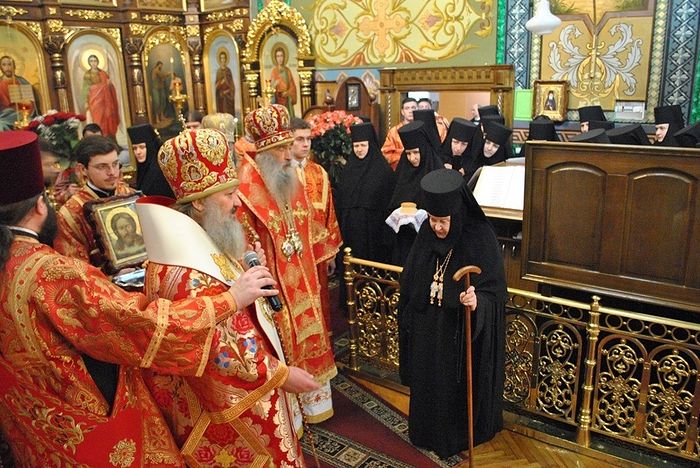 Congratulations from the Vladykas
Congratulations from the Vladykas
After the festive Liturgy, Mother received numerous congratulations, the monastic and children’s choirs proclaimed “Many years” to the abbess, and an endless stream of people came to the Theophany Church with bouquets of flowers. Mother Marionilla thanked everyone who congratulated her, humbly bowing, smiling, blessing, and giving the children chocolates. And by the end of the service, the overcast sky suddenly parted, and sunlight flooded the amazing icons in the church, including the wonderworking Kremenets Sorrowing Icon of the Mother of God. And then I thought: How many prayers, tears, and sighs, how many labors, sorrows, and thanksgiving to God have been placed upon the Lord’s altar by this ascetic over the many years and decades of her monastic podvig!
Metropolitan Pavel, the abbot of the Kiev Caves Lavra, spoke about how bravely the sisters endured the closing of the monastery in 1959; about how he met Mother Marionilla and she told him about the terrible day when the nuns left the monastery with tears in their eyes, how they hid the Plaschanitsa under their clothes, and how they carried their native icons and liturgical utensils out.
Mother Marionilla was asked to speak about her life and monastic ministry the next day after the celebrations were over.
Mother Marionilla’s story: childhood at the walls of the monastery
I was born in the neighboring Shumsky District, in the picturesque village of Obich, in 1933—Mother said, telling her leisurely story.—After the collapse of the Russian Empire, the Volyn Region became part of the Polish Republic. And in 1939, our lands became part of the USSR. My parents, Peter and Neonilla, were simple peasants, hard workers, and deeply faithful, so they raised their children in the faith. Not far from our house was the St. Nicholas Monastery. I still remember the nuns from that time—loving, humble women of prayer, and great laborers in the Lord’s vineyard. Residents of the villages of Volyn always treated the nuns with great respect, knowing that as long the habitations of the Lord stand on the earth and prayers are elevated to God, the gates of hell will not overcome the Church of Christ.
We had a mill; horses would turn the millstones, and the flour ran in a fragrant stream into special wooden troughs and was then poured into bags. Thus we lived, working the land, laboring very, very hard in the sweat of our brow.
You know when someone lives on Earth as long as the Lord blessed me, memories of childhood become especially vivid with age for some reason, as if you’re returning to the distant past. You see our watery meadows, you as if hear the singing of birds, the ringing of bells coming from the monastery bell tower. This ringing was especially pleasant, as if someone was calling me there, to the monastery…
My father Peter was a very religious man, always praying. I remember, when the grain was being harvested in the fields, the peasants had to be on duty at the harvest, to ward off flocks of sparrows that would swoop into the fields. My father would take me to the field with the words: “Let’s go, Marika, we’ll go around the field with prayer,” and we would walk through the wheat and corn being reaped, singing the 90th psalm. And, amazingly, not a single sparrow would land on our field after that. Our neighbors were amazed and asked what prayer our father was reading. Then I understood that prayer is our most important work on Earth. Without prayer, life loses its meaning.
In the St. Nicholas, Kremenets, and Korets Monasteries
I thought a lot about monasticism from my childhood. My parents and I went to Pochaev Lavra and other monasteries many times. Perhaps the proximity of Pochaev left its mark on the general religiosity of the residents of Volyn. It’s no wonder so many priests, monastics, and hierarchs have come from our region! For example, more than 200 clergymen came from the village of Zalezhtsy, not far from Pochaev, at the end of last century and beginning of this century! And from the village of Zagaitsy, where the men’s monastery of St. John the Merciful has been revived, there have been 120 servants of the altar. It used to be considered an honor when someone from your family, a son or daughter, became a monastic and prayed for the entire family. The Lord vouchsafed me to enter the Obich-St. Nicholas Monastery at seventeen. My parents blessed me with tears in their eyes. I remember, my mother would ask: “What are you going to do there, daughter?” “Whatever they say, that’s what I’m going to do,” I would answer. It’s been seventy years since then…
I stayed at the Obich-St. Nicholas Monastery a little more than three years until in 1953, after the death of Stalin, they closed the monastery, and the other sisters and I, with the blessing of the hierarchy of our Church, moved to the Kremenets-Theophany Monastery, which also became a native home for us. Another six years of my monastic obedience went by there. It used to be that the sisters received the tonsure only after a long novitiate, often of many years. That’s how it was for me. I received the monastic tonsure in Korets Monastery, where the Kremenets sisters moved in 1959, after it was closed by the authorities.
I’ll say a few words about our Kremenets Monastery, founded under Metropolitan Peter (Mogila) in 1636. During the Second World War, it hosted the residence of Metropolitan Alexei (Gromadsky) of Volyn, murdered in 1943 by nationalist bandits, presumably for condemning the nationalist Church schism and for loyalty to the Mother Russian Orthodox Church. Now the relics of the hieromartyr are preserved in our monastery and await the time of his glorification among the holy martyrs.
I remember the final service before the closing of Kremenets Monastery. The sisters gathered at the main icon—the wonderworking Sorrowing Icon—sang an akathist, and wept. But there was a feeling that in any case we would return there. This hope didn’t leave us Kremenets sisters for three decades.
I bore various obediences over the years at the Korets-Holy Trinity Monastery. It is no less an ancient monastery, founded in the 16th century, with no less an interesting history. During the civil war, the Russian Monastery was located on the territory of Poland and took many orphans under its protection. The Poles wanted to give the monastery to the Catholics, and there was even a case in Paris about it, which the Catholics lost. Then they decided to take the monastery by military force. A platoon of Polish soldiers came from Rivne, led by a lieutenant by the name of Adamkewicz. The abbess of the monastery, Mother Theophania said to the sisters: “There is no one to protect us but the Mother of God. Let us strictly fast and read forty akathists at our wonderworking Surety of Sinners Icon. And what do you think? On the way to the monastery, Lieutenant Adamkewicz stopped his horse and fell to the ground with the words: “Don’t touch the monastery. I have been struck by an angel of the Lord.” And he died. Thus the Mother of God saved the monastery.
When we moved to Korets in 1959, sisters from Derman Monastery also soon came there, and the monastery already had more than 200 sisters. It was difficult, the cells were full, but we greatly labored and prayed a lot, not falling into despondency. Many of the Kremenets nuns didn’t live to see the return, departing for the eternal abodes. But part of the sisters, including me, saw this day, thirty years later…
The rebirth of the Kremenets Monastery
Yes, thirty years have passed—Mother Marionilla said, continuing her story.—You know, our wonderworking Sorrowing Icon of the Mother of God was preserved in the Pochaev Lavra all these years. Then, on the eve of the feast of the Dormition, August 26, 1990, when the state had already decided to return the Kremenets-Theophany Monastery to the Church, a large cross procession set out from the walls of the Pochaev Lavra, led by our current primate His Beatitude Metropolitan Onuphry, then an archimandrite and abbot of the Pochaev Lavra, which he had led since 1988.
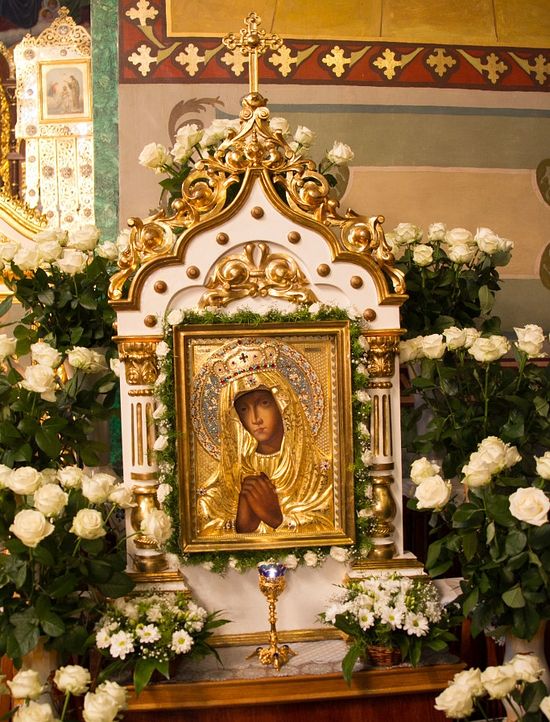 The wonderworking Krements Sorrowing Icon of the Mother of God
The wonderworking Krements Sorrowing Icon of the Mother of God
Our dear Vladyka Onuphry was already manifesting an extraordinary courage then, and a determination to surrender himself, the brothers, and his flock to the will of God.
It turns out that officials from Ternopil and Kremenets called him advising him to stop the cross procession, because a crowd of aggressive nationalists had gathered at the walls of the monastery in Kremenets, led by a political patron—the People’s Deputy Vasily Chervony, who promised not to leave “a single church of the Moscow Patriarchate” in Volyn. Later, about ten years ago, he was struck by lightning and died…
Of course, we were all worried.
But Fr. Onuphry replied: “Brothers and sisters, the wonderworking icon of the Most Holy Theotokos is with us. It’s her will to return to her native monastery. She will not abandon us and will not allow any conflicts.” And a miracle happened. When we had gone fifteen miles and arrived chanting at Kremenets, our detractors who had gathered at the entrance of the monastery suddenly stepped aside, and we entered the territory of our native monastery unhindered.
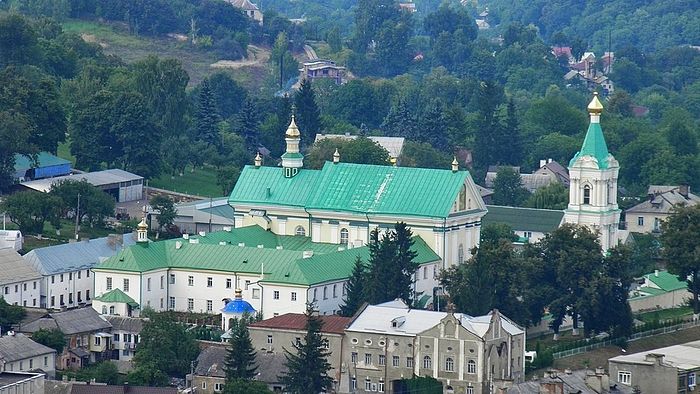 Kremenets-Theophany Monastery today
Kremenets-Theophany Monastery today
A few months later, Fr. Onuphry was elevated to the rank of bishop and sent to the Chernivtsi-Bukovina Diocese.
Since then, our dear Vladyka has visited us many times, and never forgets about the monastery. And now he sent his greeting on my name’s day…
Farewell
When we returned here, we found an abomination of desolation. A gym had been built in the Theophany Church, with lines still painted on the floor, and the church needed a complete reconstruction. There was still a city hospital operating on the territory, and there were hospital wards in the monastic buildings. We, the few sisters, were huddled in the sacristy—damp, with blackened walls. There was water under the floor of the church, the bell tower was completely destroyed, and what is now the St. Nicholas Church housed a hospital morgue.
We suffered this way for half a year, praying to the Mother of God and waiting for the hospital to be moved completely. Then, one beautiful day, all the parturient women were suddenly moved out of the renovated former monastic residence building (there was a maternity ward there), because of the danger from some virus. The renovated former monastic cells stood empty, clean, and smelling of fresh paint. What to do? We decided to move in!
Thus, our Mother, the Theotokos herself, provided us with renovated cells to live in. Glory to God.
You can’t say everything; you’ve seen the monastery yourself. It’s like a blooming desert oasis in the raging sea of life…
In August of this year, God willing, we will celebrate the thirtieth anniversary of the rebirth of the monastery—Mother Marionilla said, finishing her narrative.—If God grants me to live until then…
***
We bid farewell to the beautiful Kremenets Monastery and its hospitable abbess Mother Marionilla, took her blessing, and wished her many years.
And now, finishing these lines, I would like to repeat: “Many, many years, dear Mother!”

